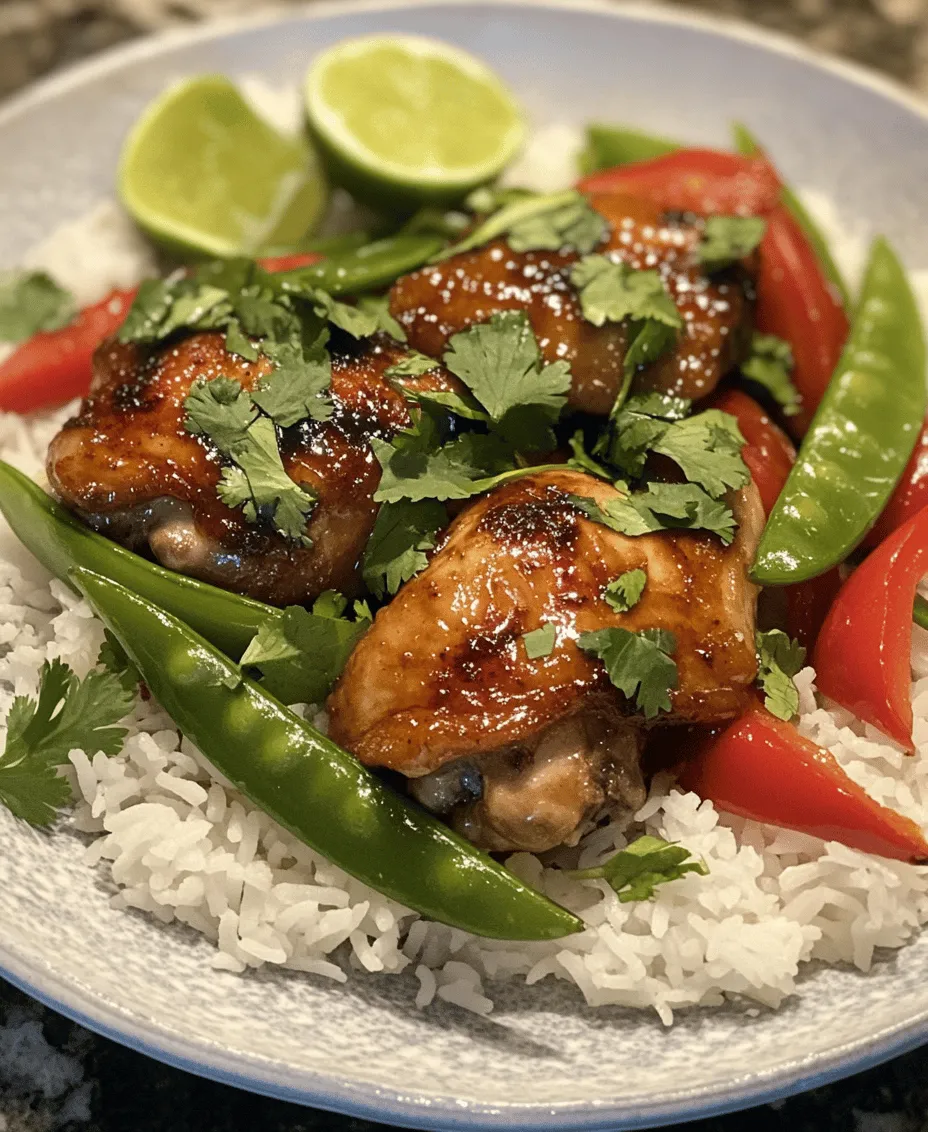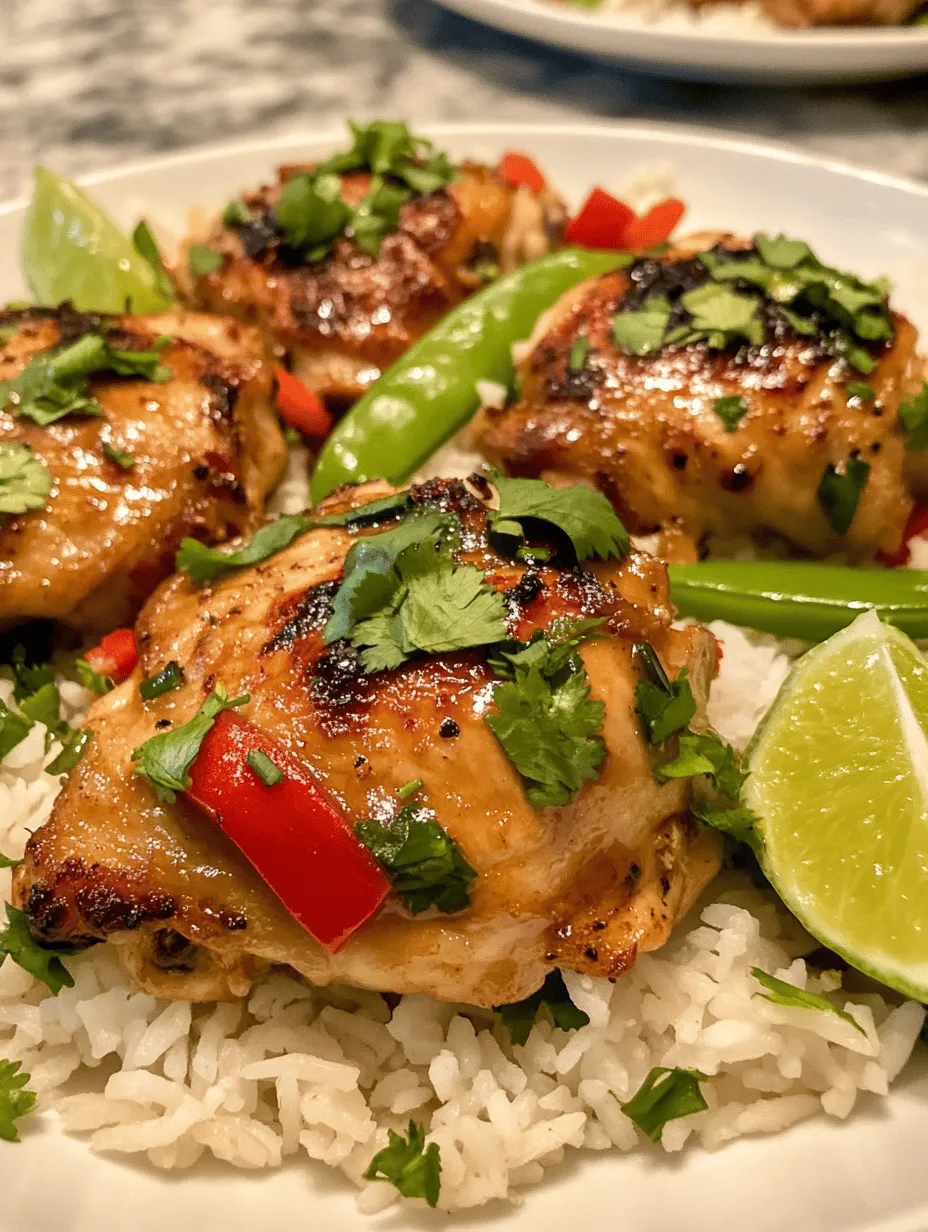Introduction
Discover the vibrant and enticing flavors of Thai cuisine with our Sweet and Spicy Thai Chicken recipe. This dish is a harmonious blend of succulent marinated chicken, fresh vegetables, and a medley of bold sauces, resulting in a meal that’s not only delicious but also incredibly easy to prepare. Whether you’re a seasoned home cook or just beginning your culinary journey, this recipe will guide you through each step, ensuring a satisfying experience that will transport your taste buds to the streets of Thailand.
Thai cuisine is celebrated for its unique ability to combine contrasting flavors—sweet, spicy, sour, and salty—into a single dish, creating a symphony of tastes that delight the senses. Sweet and Spicy Thai Chicken exemplifies this principle, balancing the heat from spices with the sweetness of honey and the tang of lime juice. As we dive into the details of this recipe, you’ll learn not only how to create this dish but also the foundational elements that make Thai flavors so compelling.
Understanding the Flavor Profile of Thai Cuisine
To truly appreciate the allure of Sweet and Spicy Thai Chicken, it’s essential to understand the core elements of Thai cooking. The flavor profile of Thai cuisine is characterized by a delicate balance of sweetness, spiciness, and savory notes, often enhanced by fresh herbs and spices.
Exploring the Essentials of Thai Flavors
1. The Balance of Sweet, Spicy, and Savory: Thai dishes are renowned for their ability to harmonize contrasting flavors. In our Sweet and Spicy Thai Chicken, the sweetness from honey counteracts the heat of Sriracha, while savory elements come from soy sauce and fish sauce. This balance creates a complex taste experience that keeps you coming back for more.
2. Key Ingredients that Define Thai Cooking: Essential ingredients in Thai cuisine include fish sauce, soy sauce, lime juice, and an array of fresh herbs and spices like cilantro, basil, and chilies. Each ingredient plays a crucial role, contributing to the overall flavor and aroma of the dish.
3. The Role of Fresh Herbs and Spices: Fresh herbs like cilantro and Thai basil are often used as garnishes and flavor enhancers. They add brightness and freshness that elevate the dish. Spices such as ginger and garlic infuse the chicken with aromatic depth, making each bite a delightful experience.
Ingredients Breakdown
Now that we have an understanding of the flavor profile of Thai cuisine, let’s delve into the essential components of our Sweet and Spicy Thai Chicken recipe. Each ingredient has been carefully selected to enhance the dish’s overall flavor and texture.
1. Chicken Thighs: The Preferred Cut for Flavor and Moisture
– Chicken thighs are the star of this recipe, chosen for their rich flavor and moist texture. Unlike chicken breasts, thighs remain juicy and tender, even after cooking. This makes them ideal for marinating and quick cooking methods like stir-frying.
2. Vegetable Oil: Choosing the Right Cooking Oil
– Selecting the right cooking oil is crucial for achieving the perfect sear on your chicken while preventing it from sticking to the pan. Vegetable oil or peanut oil are excellent choices due to their high smoke points and neutral flavors.
3. The Aromatic Duo: Garlic and Ginger
– Garlic and ginger are staple aromatics in Thai cooking. Their pungent flavors infuse the chicken with depth, while also contributing to the overall aroma of the dish. Freshly minced garlic and ginger are recommended for the best flavor outcome.
4. Fresh Vegetables: Bell Peppers and Snow Peas
– For added color and crunch, we incorporate fresh vegetables like bell peppers and snow peas. These not only enhance the visual appeal of the dish but also provide a refreshing contrast to the rich flavors of the chicken and sauce.
5. The Marinade: A Symphony of Sauces
– The marinade is where the magic happens, combining several key ingredients to infuse the chicken with flavor. Here’s a breakdown of what you’ll need:
– Soy Sauce: Adds umami and saltiness to the dish.
– Fish Sauce: A quintessential ingredient in Thai cooking that imparts a deep, savory flavor.
– Honey: Provides natural sweetness and helps caramelize the chicken during cooking.
– Sriracha: Adds a kick of heat and a touch of sweetness, making it a staple in many Thai dishes.
– Lime Juice: Introduces acidity and brightness, enhancing the overall flavor.
– Cornstarch: Used to thicken the sauce, giving it a glossy finish that clings to the chicken beautifully.
6. Garnishing: Fresh Cilantro and Lime
– To finish off the dish, fresh cilantro and lime wedges are used as garnishes. Cilantro adds a burst of freshness, while lime provides an extra zing that brightens the flavors.
Preparation Steps
Now that we have our ingredients ready, it’s time to focus on the preparation steps. Proper preparation is key to ensuring that the chicken absorbs the marinade’s flavors and cooks evenly.
Marinating the Chicken
– Importance of Marination for Flavor Enhancement: Marinating the chicken is a crucial step that allows the flavors from the marinade to penetrate the meat. This not only enhances the taste but also helps to tenderize the chicken, resulting in a juicy and flavorful final dish.
– Recommended Marination Time: For optimal flavor, it is recommended to marinate the chicken thighs for at least 30 minutes. However, if time permits, marinating for 2 to 4 hours—or even overnight—will yield even better results. Just be sure to keep the chicken refrigerated while marinating to prevent any food safety issues.
Cooking the Chicken
Once the chicken has been marinated, it’s time to cook it to perfection. The cooking method used here will help you achieve that signature Thai flavor and texture.
1. Heat the Oil: In a large skillet or wok, heat a tablespoon of vegetable oil over medium-high heat. A hot cooking surface is essential for a good sear and to lock in the juices of the chicken.
2. Add the Chicken: Remove the chicken from the marinade, allowing any excess liquid to drip off. Place the chicken thighs into the hot skillet, skin-side down if using skin-on thighs. Sauté for about 5-6 minutes without moving them, allowing a nice golden crust to form.
3. Flip and Cook Through: After the first side is nicely browned, flip the chicken over and cook for an additional 5-6 minutes, until the chicken is cooked through and reaches an internal temperature of 165°F (75°C).
4. Incorporate the Vegetables: Once the chicken is almost done, add the sliced bell peppers and snow peas to the skillet. Stir-fry for about 2-3 minutes, until the vegetables are tender-crisp. The goal is to retain their vibrant color and crunch.
5. Thicken the Sauce: If a thicker sauce is desired, mix a teaspoon of cornstarch with a tablespoon of cold water to create a slurry. Add this to the pan and stir well, allowing the sauce to thicken and coat the chicken and vegetables.
Through these steps, you’ll create a dish that embodies the essence of Thai cooking—bold, aromatic, and utterly delicious. Stay tuned for the next part, where we’ll explore serving suggestions, tips for the best results, and answer some common questions about this delightful recipe.

Proper Searing Techniques for Flavor Development
Searing the chicken is crucial for developing rich flavors in your Sweet and Spicy Thai Chicken. Proper searing locks in moisture and creates a beautiful crust, enhancing the overall taste of the dish. To achieve the best results, ensure your skillet is hot enough before adding the chicken. A cast-iron skillet or a heavy-bottomed pan works best for even heat distribution.
1. Preheat the Skillet: Heat your skillet over medium-high heat for about 5 minutes. You can test if it’s ready by sprinkling a few drops of water onto the surface; they should dance and evaporate quickly.
2. Add Oil: Once the skillet is hot, add a tablespoon of high-smoke-point oil, such as vegetable or canola oil. Swirl it around to coat the bottom evenly.
3. Sear the Chicken: Place the chicken thighs in the skillet, ensuring they don’t touch each other. This will allow for even browning. Sear for about 3-4 minutes on each side until they develop a golden-brown crust. Avoid moving the chicken around too much during this process; letting it sit ensures a good sear.
How to Know When the Chicken is Cooked Through
To ensure your chicken is perfectly cooked, use a meat thermometer to check its internal temperature. The USDA recommends that chicken reach an internal temperature of 165°F (75°C). Insert the thermometer into the thickest part of the thigh without touching the bone for an accurate reading. Additionally, the juices should run clear when the chicken is pierced. If they are pink, continue cooking.
Stir-Frying the Vegetables
Once your chicken is seared and set aside, it’s time to stir-fry the vegetables. This step is essential for adding freshness and crunch to your dish while enhancing the overall flavor profile.
1. Choosing Your Vegetables: Common choices for this dish include bell peppers, carrots, and snap peas. Feel free to add other favorites like broccoli or zucchini.
2. Timing for Optimal Vegetable Crispness: Begin by adding your firmer vegetables, such as carrots and bell peppers, to the hot skillet. Stir-fry for about 2-3 minutes until they start to soften but still retain some crunch. Next, add softer vegetables, such as snap peas, and stir-fry for an additional minute.
Techniques to Enhance Vegetable Flavor
To elevate the flavor of your vegetables, consider the following techniques:
– Seasoning: Sprinkle a pinch of salt and pepper as you cook the vegetables. This will enhance their natural flavors.
– Aromatics: Adding minced garlic and ginger to the skillet during the last minute of cooking will infuse the vegetables with a fragrant aroma and taste.
– Sauce Addition: If you have a little leftover marinade or sauce from the chicken, you can add it to the vegetables for an extra punch of flavor.
Combining and Thickening the Sauce
Now it’s time to bring everything together with the sauce. The key to a harmonious dish is allowing the flavors to meld while achieving the right consistency.
1. The Simmering Process for Flavor Infusion: In a separate bowl, mix together your sauce ingredients: soy sauce, fish sauce, honey, and lime juice. Pour this mixture into the skillet with the stir-fried vegetables. Bring it to a gentle simmer, allowing the flavors to meld for about 2-3 minutes.
2. Achieving the Right Sauce Thickness with Cornstarch: To thicken your sauce, create a cornstarch slurry by mixing one tablespoon of cornstarch with two tablespoons of cold water in a small bowl. Stir well until smooth. Gradually add the slurry to the simmering sauce while whisking continuously. Cook for an additional minute until the sauce thickens to your desired consistency.
Returning the Chicken to the Skillet
Once your sauce is perfectly thickened, it’s time to reintroduce the chicken to the skillet.
1. Incorporating Chicken into the Sauce for Maximum Flavor: Add the seared chicken thighs back into the skillet, ensuring they are well-coated in the sauce. Allow them to simmer for 2-3 minutes to absorb the flavors fully.
2. Adding Fresh Green Onions for Extra Crunch: Just before serving, stir in sliced green onions for a fresh, crunchy finish. This not only adds flavor but also a vibrant pop of color to your dish.
Serving Suggestions
Plating your Sweet and Spicy Thai Chicken beautifully can enhance the dining experience.
Plating the Dish: Aesthetic Presentation
– Serving Over Steamed Jasmine Rice vs. Noodles: This dish pairs wonderfully with steamed jasmine rice, which absorbs the sauce beautifully. Alternatively, serve it over rice noodles for a delightful twist. Create a bed of rice or noodles on the plate and artfully arrange the chicken and vegetables on top.
– The Role of Garnishes in Enhancing Visual Appeal: Lastly, consider garnishing with additional green onions, sesame seeds, or cilantro for a fresh touch. Not only do these add visual appeal, but they also contribute to the flavor profile.
Nutritional Benefits of Sweet and Spicy Thai Chicken
This dish is not only delicious but also packed with nutritional benefits.
Health Benefits of the Ingredients
– Chicken Thighs: Protein and Nutritional Value: Chicken thighs are a great source of protein, essential for muscle growth and repair. They also contain healthy fats, which help keep you satiated.
– The Health Benefits of Ginger and Garlic: Both ginger and garlic are known for their anti-inflammatory properties. Ginger aids digestion and adds a unique flavor, while garlic supports immune health and has cardiovascular benefits.
– Nutritional Advantages of Fresh Vegetables: The array of vegetables in this dish provides vitamins, minerals, and antioxidants, contributing to overall health and wellness. They add fiber, which is essential for digestive health.
Variations and Customizations
This recipe is versatile and can be adapted to suit various dietary preferences.
Adapting the Recipe for Different Dietary Preferences
– Vegetarian & Vegan Alternatives: Substitute chicken with firm tofu or tempeh for a vegetarian or vegan version. Ensure to press and marinate the tofu to absorb the flavors.
– Adjusting Spice Levels for Different Palates: If you prefer a milder dish, reduce the amount of chili paste or fresh chilies. For those who enjoy extra heat, consider adding more chili or a sprinkle of red pepper flakes.
– Incorporating Seasonal Vegetables: Feel free to adjust the vegetable selection based on what’s in season. Seasonal vegetables not only enhance flavor but also ensure you’re getting the freshest produce.
Conclusion
Sweet and Spicy Thai Chicken is more than just a meal; it’s an exploration of flavors that can bring joy to your dining table. With its easy preparation and customizable nature, this dish is perfect for weeknight dinners or special occasions. Embrace the boldness of Thai cuisine and enjoy a dish that promises to satisfy both your taste buds and your nutritional needs. Whether you serve it over rice or noodles, this recipe is sure to become a favorite in your culinary repertoire, inviting everyone to savor the delightful medley of sweet, spicy, and savory notes that define this Thai classic.



